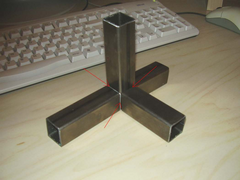
Welding help - 3 tubes at once
Mansfield - 29/12/06 at 08:53 PM
Its welding practice tomorrow.
The attached picture shows 4 offcuts arranged as one of the typical '4 tubes coming together' joints found in the locost chassis.
Am I supposed to weld the red arrowed joints to catch all 3 tubes at once?
Thanks, David.


Rescued attachment Pc290032.jpg
nitram38 - 29/12/06 at 09:03 PM
Before you fully weld them, tack weld each join. In between tacks, check the angles and give them a bit of bend if necessary to get your angles
back.
When you weld into corners, you will find that the weld will pull the metal out of square. The tacks will help.
If you rotate the work piece, you will find running a vertical weld from top to bottom will make a nice concave weld in internal corners.
When welding a full chassis, tacking the whole thing together first is recommended before welding everything completely.
You will soon find with a bit of practice to weld opposing welds so as not to warp the chassis.
[Edited on 29/12/2006 by nitram38]
macnab - 29/12/06 at 09:22 PM
Do you think tacking them in the middle of the tube would be best? I tend to do this so that the weld will be continuous round the corners (since
thatís where fatigue cracks tend to form) and then weld over the tacks at the end.
Just a thought...
nitram38 - 29/12/06 at 09:26 PM
No, I weld on corners as the tack will grab two sides. Welding in the middle can cause a bump in the middle of the weld.
macnab - 29/12/06 at 09:43 PM
hmm good point. 
gazza285 - 29/12/06 at 09:52 PM
Fully weld the first two, then grind back flush where you need to weld another to, fully weld that, then grind back flush what you need to weld the
last to. Unless you are confident with the welder and know that you have the right power for a full penetration weld it's the way to go. Tack the
corners first to avoid the bump in the middle, and the tacks in the corner will also prevent the weld tailing off when you finish the run.
Mark Allanson - 30/12/06 at 10:22 PM
quote:
Originally posted by gazza285
Fully weld the first two, then grind back flush where you need to weld another to, fully weld that, then grind back flush what you need to weld the
last to. Unless you are confident with the welder and know that you have the right power for a full penetration weld it's the way to go. Tack the
corners first to avoid the bump in the middle, and the tacks in the corner will also prevent the weld tailing off when you finish the run.
I agree with most of what gazza has said, but I am a bit worried about tacking the corners. If a weld fails, it will be from the end of the weld, and
a tack can only add to the chances of getting inclusions or lack of penetration (the start of the weld is always the coldest). A lump in the middle of
the weld is an aesthetic problem, and if you are using enough heat, this will be spread over the remainder of the weld.
Tack 3/4 along the proposed weld path, start the weld just off the adjoining side and run through the weld path, and just overlap the corner, dress
down the overlaps with a grinder and move on to the next face.
If you work clockwise on the right hand side of the car, do anticlockwise on the left, self cancelling distortion.
nitram38 - 30/12/06 at 10:25 PM
Have you ever tried to seperate the weld on these? 
I welded stuff like this for a living for 5 years!!!
You are more likely to have a tube fracture than a weld failure !!!
[Edited on 30/12/2006 by nitram38]
Mark Allanson - 30/12/06 at 10:57 PM
I have never had a weld 'separate' in 20 years of welding.
I have sliced a few and nitro'd a few to show students the lack of penetration at the start of welds though
gazza285 - 30/12/06 at 11:14 PM
Should really add that more power=more penetration then, meaning that the power should be right for the job. Biggest problem I see with amateurs
welding is lack of power, don't be frightened of it, get the power up and practice. Working hot and fast gives nice penetration and a neat
finish, but takes practice. Also wherever you put the tacks, make sure that they are big enough to hold the tube against the contraction of the
opposing weld, seen quite a few tacks broken by the opposite weld.





